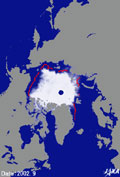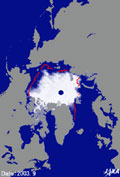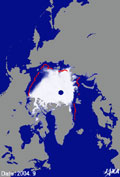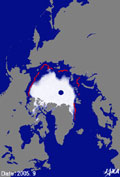Seen from Space 2006
Sea ice in the Arctic Ocean continues to recede. In 2005 it reached its smallest extent since observation began by spaceborne microwave radiometers.
Over the past several years, the distribution of summer sea ice in the Arctic Ocean has diminished. (see our topic, "Will a Tour of the North Pole by Dog Sledge be Possible?" Reduction of Sea Ice in the Arctic Circle, as Seen from Space.)
Now, according to a recent report from the summer of 2005, the extent of sea ice is smaller than at any time in the history of microwave space observation.
The sea ice extent in the Arctic Ocean in Septembers around 1980 was approximately 7.5 million km2, but the sea ice extent has decreased gradually with fluctuating a little year to year *2. It recorded minimum in the observation with approximately 5.3 million km2 in September 2005 after approximately 6.0 million km2 in September 2004. Satellite microwave observation of sea ice in the Arctic Ocean has been carried out continuously since 1978. The distinguishing feature of the sea-ice change this year is that it began to decrease earlier than usual and continued to decrease well past the latest recorded time (the end of September). This year, again, there was not enough recovery of the sea ice over the winter. The decline in sea ice continued to reach new low levels in the history of observation since December 2004 except for May 2005. This is a difficult phenomenon to explain by ideas from the past, such as Arctic oscillation, and there is some thought that global warming may influence. Sea ice is not easily warmed because it strongly reflects sunlight. In contrast, the sea surface warms easily by absorbing sunlight. The air temperature rises and the sea ice decreases faster if the area of the sea ice decreases and the area of the sea surface increases because the heat absorbed by the Arctic increases. Over the past ten years, the normal temperature of the Arctic circle rose 2 to 3°C above the normal temperature of the previous 50 years, and since 2002 the thaw has begun 2 to 3 weeks earlier in Alaska and Siberia. These phenomena cause great concern about the influence on the climate and the ecosystems. In the future, JAXA will continue to report on this phenomenon and its effect on climate change by using spacecraft observation.
|
|||||||||||||||||||








